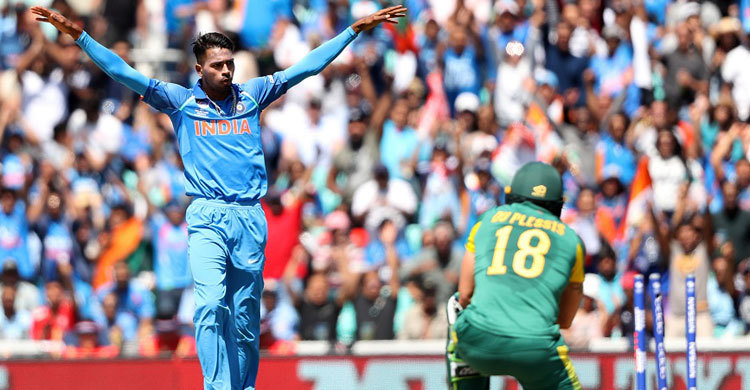Disciplined India run dysfunctional South Africa out

Faf du Plessis scored 36 in the quarter-final of the 2011 World Cup. He scored 36 in the virtual quarter-final of the 2017 Champions Trophy. On both those occasions, he was involved in the run-out of AB de Villiers. In 2011, the run-out proved to be the moment the match went away from them; they were now left needing to defend 191 if they were to avoid another underwhelming exit at a world event. Du Plessis went on to run David Miller out, and South Africa contrived to lose eight wickets for 51 runs from 140 for 2 in the 29th over on a used pitch, slower than the ones The Oval has laid out.
India didn’t need to indulge in the mind games that New Zealand resorted to six years ago; they were just excellent with their defensive bowling in the first half, took the run-outs on offer, and then circled in for the kill with aggressive bowling changes. A measure of their discipline was how Quinton de Kock scored just five runs out of 53 square or behind square on the off side; one of them was a reverse sweep. They fell short of being magical in the field, but they showed they were not to be pushed around, reaching six run-outs, the highest in this tournament.
India were relieved when they won the toss and passed the onus of how hard to go in the middle overs when setting a target to South Africa. Soon they saw the ball refused to swing or seam once again, and were quick to bowl to contain. Bhuvneshwar Kumar and Jasprit Bumrah cramped de Kock up, bowling nothing outside off. Bhuvneshwar even brought the third man up to afford a deep point, which resulted in de Kock’s failed attempts to drag the ball to leg from just outside off. Hashim Amla struggled to time the ball, which was a sign the pitch was slow, and there was a need to recalibrate their total.
By the time Hashim Amla walked across and took a risk to hit Hardik Pandya for a six - his first boundary in 25 balls - India had kept South Africa down to 52 in 14 overs. Hardly a bad ball was bowled in those 14 overs. Three of those 14 overs were bowled by R Ashwin, coming back into the side ahead of Umesh Yadav. Ashwin soon got Amla when he went back to hit a fullish ball square, instead of hitting cover, a better option. MS Dhoni accepted the thick deflection coolly.
Du Plessis made a fluent start to his innings, scoring on each off the first seven deliveries he faced. The energy rubbed on to de Kock, who showed remarkable patience in not playing low-percentage cricket. The run rate gradually went up 3.5 in 10 overs to 4.7 in 20 to 4.83 in 24. De Kock had reached 50 for the sixth time against India; his previous five had been hundreds. South Africa were back on course. Then Ravindra Jadeja, fresh from an ordinary game against Sri Lanka, began his fifth over. The room outside off remained elusive, and finally the low-percentage sweep arrived, claiming de Kock.
De Villiers and du Plessis started off promisingly, adding 24 off 28 without breaking a sweat. Then du Plessis hit to point, and de Villiers, fresh off a hamstring niggle, didn’t shout no. The call here was the non-striker’s, de Villiers was well within his rights to send du Plessis back, but he didn’t. The big dive in the end did nothing for him. In the next over, du Plessis got a ball to the left of short third man, India’s weakest fielder, Bumrah. He set off, then stopped, then set off again, and by now David Miller just responded. Suddenly, though, du Plessis made a U-turn and beat Miller to the striker’s end. Bumrah’s throw was bad, but that worked in India’s favour as they completed an easy run-out at the non-striker’s.
Du Plessis was on 27 off 31 when de Villiers was run out. He managed nine off the next 18 before chopping Pandya on in a manner identical to his dismissal against Pakistan. India could have easily set into template and bowled their spinners out. However, they bowled spin at one end and actively looked for wickets at the other. And the wickets arrived: Chris Morris and Andile Phehlukwayo to Bumrah, and Kagiso Rabada and Morne Morkel to successive Bhuvneshwar deliveries.
Just to sum up how dysfunctional South Africa had been, Imran Tahir was the last man run-out, not clear enough in his mind that it was his job to give the strike to JP Duminy, who left ended unbeaten on 20. Thirty-three balls were left unused.
Source: ESPNcricinfo


